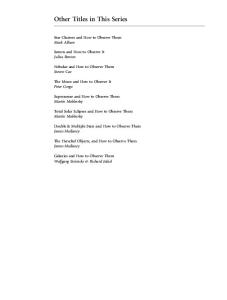Faint Objects and How to Observe Them
Astronomers' Observing Guides provide up-to-date information for amateur astronomers who want to know all about what it is they are observing. This is the basis of the first part of the book. The second part details observing techniques for practical astr
- PDF / 609,489 Bytes
- 22 Pages / 504 x 666 pts Page_size
- 103 Downloads / 391 Views
Series Editor Dr. Michael D. Inglis, BSc, MSc, Ph.D. Fellow of the Royal Astronomical Society Suffolk County Community College New York, USA [email protected]
For further volumes: http://www.springer.com/series/5338
wwwwwwwwww
Brian Cudnik
Faint Objects and How to Observe Them with 69 Illustrations
Brian Cudnik Leaf Oak Drive 11851 Houston, Texas, USA
ISSN 1611-7360 ISBN 978-1-4419-6756-5 ISBN 978-1-4419-6757-2 (eBook) DOI 10.1007/978-1-4419-6757-2 Springer New York Heidelberg Dordrecht London Library of Congress Control Number: 2012942846 © Springer Science+Business Media New York 2013 This work is subject to copyright. All rights are reserved by the Publisher, whether the whole or part of the material is concerned, specifically the rights of translation, reprinting, reuse of illustrations, recitation, broadcasting, reproduction on microfilms or in any other physical way, and transmission or information storage and retrieval, electronic adaptation, computer software, or by similar or dissimilar methodology now known or hereafter developed. Exempted from this legal reservation are brief excerpts in connection with reviews or scholarly analysis or material supplied specifically for the purpose of being entered and executed on a computer system, for exclusive use by the purchaser of the work. Duplication of this publication or parts thereof is permitted only under the provisions of the Copyright Law of the Publisher’s location, in its current version, and permission for use must always be obtained from Springer. Permissions for use may be obtained through RightsLink at the Copyright Clearance Center. Violations are liable to prosecution under the respective Copyright Law. The use of general descriptive names, registered names, trademarks, service marks, etc. in this publication does not imply, even in the absence of a specific statement, that such names are exempt from the relevant protective laws and regulations and therefore free for general use. While the advice and information in this book are believed to be true and accurate at the date of publication, neither the authors nor the editors nor the publisher can accept any legal responsibility for any errors or omissions that may be made. The publisher makes no warranty, express or implied, with respect to the material contained herein. Printed on acid-free paper Springer is part of Springer Science+Business Media (www.springer.com)
I would like to dedicate this to my astronomy friends who have passed on from this life: Don “Captain Comet” Pearce, Rick Hillier, George Stradley, Richard Bunkley and others. May your legacies shine on like stars in the universe.
wwwwwwwwww
wwwwwwwwww
Brian Cudnik has been an amateur astronomer for over 30 years and manages the Physics laboratories at Prairie View A & M University (a part of the A & M University of Texas). He has been the coordinator of the Lunar Meteoritic Impact Search section of the Association of Lunar and Planetary Observers (ALPO) since January 2000. Cudnik began at ALPO 2 months after it made the
Data Loading...











